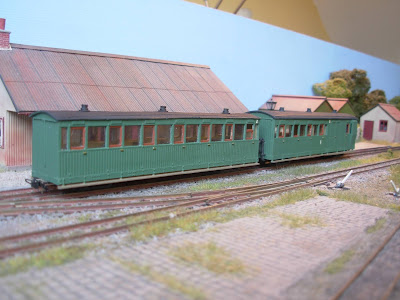Locomotives of the
Isle of Wight Railways
The railways of the Isle of Wight have always held a special fascination for enthusiasts. My own first encounters with the Island’s railway system, or what was left of it, were with the truncated Ryde – Shanklin section on annual childhood visits in the 1970s. I had a fascination for the London Underground anyway, so found the ex LT ‘Standard’ stock of great interest. However, it was only after my first visit to the Isle of Wight Steam Railway at Havenstreet in 1979, my first journey behind ‘Calbourne’ and the acquisition of the first of many books on the Island’s railways, that I really started to appreciate just what an interesting network it had once been.
 Not to be confused with the excellent archive images to be seen in the book, this is my own photograph of Terrier W8' Freshwater' on a train of four-wheel stock at Ashey on the Isle of Wight Steam Railway in August 2015.
Not to be confused with the excellent archive images to be seen in the book, this is my own photograph of Terrier W8' Freshwater' on a train of four-wheel stock at Ashey on the Isle of Wight Steam Railway in August 2015.No surprise then that Crecy Publishing’s new book on the
subject of Isle of Wight locomotives has been added to my collection of Island
railway books within a few weeks of publication. Written by a well-known group
of Isle of Wight railway historians, it is I think the book that many of us
have been waiting for for many years. Although there have been accounts of
island motive power in the various individual line histories and several good
books on the tube stock this is the first time we’ve had a proper locomotive
history since D.L. Bradley’s volume from forty years ago.
This latest offering brings the story right up to date with
delivery of the class 484 former District Line ‘D’ stock trains and some
tantalising information about possible additions to the Steam Railway’s fleet.
For me the strength of the book is in the detail on the pre-grouping company’s
locomotives and the excellent illustrations. A number of older b/w images have
been colourised. This may not be to everybody’s liking but there’s no denying
that the colour images of the IWCR and IWR Beyer Peacocks in the early parts of
the book are quite stunning, as are similarly treated images of locomotives in
Southern Railway liveries. There is also a great deal of fascinating
information and data contained in the appendices.
All in all a very worthwhile addition to the book shelf for anyone interested in the Island’s railway history. A snip at £25.00.
A site no longer seen by visitors to the Island arriving at Ryde Pier Head, former LT 1938 stock unit 006 in the summer of 2018.

























.jpg)


